John Hurrell – 5 June, 2013
In his Auckland lecture Maharaj talked about artists investigating the unforeseeable and being deliberately 'clueless', using ‘no how' - not ‘know how' - within a 'guilt-free nonproductivity'. In other talks he opposes art research to that of science, comparing the ‘logic of difference' with the ‘logic of emulation', pointing out that in the art academy, there is now no known object of enquiry.
Auckland
International group exhibition and forums
If you were to live here
Curated by Hou Hanru
10 May - 11 August 2013
In this discussion I want to briefly look at some of the ideas presented by Sarat Maharaj in his keynote address and tie them into the contributions from two of the Triennial artists, Peter Robinson and Ho Tzu Nyen - exploring certain thematic commonalities that come to the fore about the unforeseen.
In his lecture, Know How & No How: Thinking through ‘art as knowledge production’ in a time of ‘Creativity Cholera‘, Maharaj looked at aspects of ‘the global contemporary’ drawing on notions he had explored earlier in several lectures now available online. Much of his thinking develops notions seeded from his interaction with the British Pop artist Richard Hamilton, when in the mid-nineties he wrote an essay for October on the problems encountered by Hamilton when he translated the contents of Marcel Duchamp’s Green Box - collaborating with Hamilton whilst incorporating their knowledge of both James Joyce and Duchamp to draw out parallels in the two personalities.
Two of the qualities shared by Joyce and Duchamp were their irreverence and their sense of the ludic. In one example, Maharaj is fascinated by Joyce’s letter reshuffling within the word ‘Progress’, changing it to ‘Pregross’ - a term for the preparatory period before a final stable conclusion, a prior unresolved state that is uncertain. In his Auckland lecture he talked about artists investigating the unforeseeable and being deliberately ‘clueless’, using ‘no how’ - not ‘know how’ - within a ‘guilt-free nonproductivity’. (See this paper and this video). Elsewhere he opposes art research to that of science, comparing the ‘logic of difference’ with the ‘logic of emulation’. (See 53 minutes in.) He points out that in the art academy there is now no known object of enquiry.
In St. Paul St’s Gallery Two we can see The Cloud of Unknowing, a spectacular video and sound installation by the Singaporean artist, Ho Tzu Nyen. ‘Cloud of Unknowing’ happens to be the title of a fourteenth century monastic text, a mystical Christian treatise describing God as a petulant lover who needs to be wooed. Ho Tzu Nyen‘s sumptuous video could be interpreted as about contemporary art as Maharaj’s knowledge system, or Christian faith as spiritual belief. It is shows eight residents of a multi-storied modernist apartment block interacting with the enigmatic mist, one hovering in mid-air with vaporous steam curling around his head, another a very loud drummer. The physical impact of the 13 channel sound is terrific.
A second video from this artist, Earth, at Auckland Art Gallery, has some of the same actors. It is a sort of Bill Viola meets Gericault, Delacroix or Caravaggio: a Raft of the Medusa with a cast of fifty sprawling bodies, designed to cram in as many random layers of meaning as possible - but with no depth. The Cloud of Unknowing is more controlled in its pace, less rambly and with a clearer sense of direction.
Peter Robinson’s work If you were to live here: the mood in the Museum is a good example of Sarat Maharaj’s artist tentatively feeling his or her way through an idea and not knowing where it will go or finish. An early draft of Robinson’s proposal in the online Triennial catalogue says that,”His felt sticks reference the formalist legacies of minimalist, post-minimalist and conceptual art, conflating these iconic art-historical conventions with both traditional Māori abstraction and taonga (treasure) forms, and genetic or binary codes, to activate a contemporary recoding and recontextualisation.” An earlier form of felt stick.
However when one looks at the later museum webpage, the project has clearly over time evolved to become a more overtly political enterprise, fitting perfectly into Hou Hanru‘s concept of examining what is it like to live and work in Auckland - in this case, to be employed by one of the major cultural ‘organs’ of Auckland Council.
By encouraging (as he does) each of the sixty museum staff to place a coloured felt ‘mood stick’ in a conspicuous location somewhere within the public displays - choosing one colour out of four possibilities (red: courageous, hopeful or amorous; yellow: easily angered or bad tempered; green: despondent, sleepless or irritable; blue: calm or unemotional) Robinson is constructing a public barometer of staff-management relations.
Assuming that the staff care about these codings and take the project seriously, that they are not jittery and will happily participate, and will each only display one stick - and that management will not snoop or record who the individual stick-placers are - the project has the potential of embarrassing Auckland Council if there were to be a predominance of yellow or green, or proclaiming all is well if there were an abundance of blue and red.
Through this work, Robinson turns the museum into an Assisted Readymade, taking the institution and by simple means exposing its social dynamic, extending the idea that Jasper Johns explored in the late fifties when he decided to “Take an object, do something with it, and then do something else with it,” after he had seen Duchamp’s work in a Dada show.
What starts off as playfulness - propelled by clueless whimsy and hunches - develops over time into purpose and focus, with meaning being discovered at the end - in hindsight.
John Hurrell
Recent Comments
John Hurrell
Remember that a Court of Law decided that manslaughter, not murder, occurred. I have already commented on the Te Tuhi ...
Ralph Paine
Briefly, Of Death & Mr Willis Thompson’s 'Untitled', Auckland Triennial, 2013 “I te rimu e māwe rā ki Mōtau” It ...
Ralph Paine
I "get out" most days John, looking for interesting cracks in the pavement or observing insect life. Standing on motorway ...
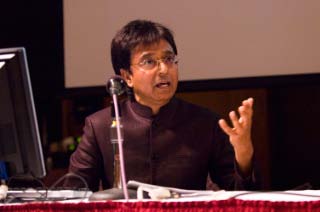
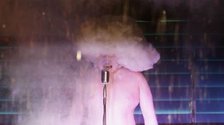
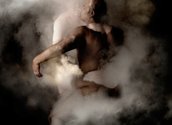
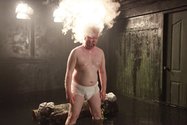
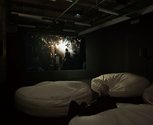
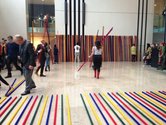
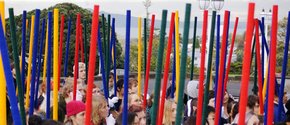
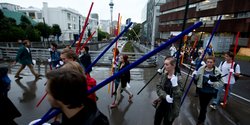

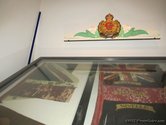
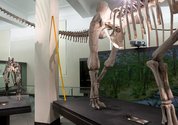
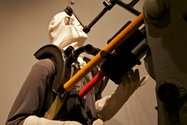

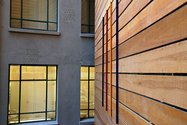
 Two Rooms presents a program of residencies and projects
Two Rooms presents a program of residencies and projects Advertising in this column
Advertising in this column



This Discussion has 22 comments.
Comment
Ralph Paine, 1:34 p.m. 6 June, 2013 #
Shameless appropriation, the use of student labour and crowd sourcing, mock sacredness, pseudo-sociology: the Mood project seems to me a political and artistic bad joke from knowing-all-too-knowing start to patronising finish. So yeah, if I worked at the Auckland Museum I’d want to grab me one of them there red sticks and stuff it right up the hole in Mr Robinson’s art practice.
It was Martha Rosler who created the title If You Lived Here, for a series of exhibitions, panel discussions, and “town meetings” organised for the Dia Art Foundation, New York, in 1988/89. Subsequently, in 1991, a book with the same name was published by Dia recording these events, with the sub-title: The City in Art, Theory, and Social Activism. If Rosler’s is the real, then the triennial has to be the repetition-as-farce, “prince and princesses” ‘n’ all. Thus Mr Boyce’s previous comments concerning the curator’s statement about Occupy, etc. are right on the money: radical cheek indeed!
FYI John: the Auckland Regional Facilities Agency, a CCO of Auckland Council, has “an interest” in the Auckland Museum but is not the employer. The Auckland Museum Trust Board is the employer. The Museum has been continually restructuring its staff for over two decades.
John Hurrell, 5:22 p.m. 6 June, 2013 #
Thanks for the correction re the Museum staff employer. However it's not very wise to dismiss a show simply because of the curator's title. Maybe you should encounter the work of the Triennial directly, honouring the ten venues with a Paine visit, before you pass judgement. Getting into and exploring the art first - evaluating the justifications for inclusion later.
Ralph Paine, 3:57 p.m. 7 June, 2013 #
What?
Who?
Do I even live here?
Sh_t... I think I must've got lost in this damn cloud of unknowing that's been hanging around these parts for weeks, months, millennia...
But hey, last time I looked out I got the distinct impression of existing in a crazy-quilt mirror world that some call the society of the spectacle.
And this site, with its endless stream of images? What wise 'n' truly encountered feed back effects are you producing John? What cult house of the simulacrum do you honour with your spectral presence?
Ralph Paine, 9:38 a.m. 9 June, 2013 #
"The near-instantaneous feedback of visual trends creates an efficient system in which all information about art is almost immediately incorporated into the production of future work. The art system, in an expanded sense, becomes a kind of self-monitoring security apparatus—autopoietically regulating images and affects into precisely the categories described above. The circulation of the meme through these bodies and works arises out of a condition of constant observation and feedback. Since this feedback is beyond both verbal discourse and context, with image begetting image, the art mirrors the very Web formats that support or produce it ... "
Just a sampling of Michael Sanchez's fascinating essay 'On Art and Transmission'
Artforum Summer 2013.... sourced 9.30 am via Eyecontact
John Hurrell, 2:02 p.m. 9 June, 2013 #
'Near-instantaneous feedback' and 'self-monitoring apparatus'... you've got to be joking,Ralph. These thoughts might be accurate for the occasional NYC university, but there is not a hell of a lot of contemporary art banter in this country, or even globally. The art world (nationally and internationally) as an organism is the opposite. It's terrified of disagreement. It pretends it doesn't exist.
Ralph Paine, 11:17 a.m. 10 June, 2013 #
The dude ain't talking about "banter" or "disagreement", whatever, he's talking about images. Read it again: "beyond both verbal discourse and context". Read the whole article, because he's talking about sites like Eyecontact, with, as I said previously, "its endless stream of IMAGES". And, its multiple links to other sites and their endless stream of images, and so on and so forth....
In other words, he's talking about the effects on the production of art caused by smart phones etc. and the internet.
And it may be news to you but there's plenty of art banter and disagreement out there, one simply needs the ear to hear it. Chances are many people are gonna shut up when the resident art critic walks their way....
John Hurrell, 12:32 p.m. 10 June, 2013 #
Of course there is plenty out there. But the point is to make the private public. And not be furtive like children - but adult. Like yourself: upfront and articulate.
John Hurrell, 12:49 p.m. 10 June, 2013 #
Ralph is reluctant to provide a link - but as he says, it is interesting - so ....
http://artforum.com/inprint/id=41241. Fits in nicely with the Francis Till review, and the activities of ArtsDiary in Auckland.
Ralph Paine, 10:29 a.m. 11 June, 2013 #
Public/private, child/adult, furtive/upfront ...
These binaries do nothing but jam the circuits, block up the flow. Thus, we might just as well say that the point is to make the public private; or that being furtive is adult-like behaviour because children are upfront.
All this is unremarkable, it gets us nowhere new or interesting.
John Hurrell, 11 a.m. 11 June, 2013 #
Yes Ralph, but your actions show that you and I agree in the value of conversation about art (and the worlds that encompass it) in public. And by pointing out Sanchez's essay, you (I gather) are alarmed by the notion of 'visibility' alone. You, I assume, would hate say, to have images of your current language-based exhibition circulated online with no accompanying discussion of the content.
Ralph Paine, 12:17 p.m. 11 June, 2013 #
By pointing out Sanchez's essay I was trying to suggest again that if the Triennial is an 'imaged' event of and for the global/globalizing art system as such, then surely the all encompassing, bodily walk-in visitations that you insist upon for comment credibility is kinda redundant.
Sanchez is mapping the current conditions of possibility for art production in an expanded sense. It's an intriguing map. Should we be "alarmed" by its contours and colouring? Guess that's a question for the general intellect of the system to process.
Meanwhile, images of my current exhibition already circulate on-line sans commentary. Whatever. No hatred.
John Hurrell, 3:55 p.m. 11 June, 2013 #
So in terms of your own practice, offline (onsite) or online is all the same to you? It is not an issue, and reproducing quality of ink on paper of no interest?
Ralph Paine, 8 p.m. 11 June, 2013 #
Early last year I ran into Simon Ingram in the city. Straight away and kinda urgently, “Could you give an artist’s talk to the Elam first year drawing students next week?” he asked. “Sure,” I replied, “but only if I can use slides. I don’t have a digital archive, just slide images from the late seventies to early nineties—after that, zilch.” “Hmmmm.... I’ll talk to Darren Glass and Sean Kerr,” he said. “They’re into old technology,” and off he went. Turned out that Darren and Sean had a lotta trouble finding a slide projector. I had a carousel, but apparently Auckland University had dumped all its projectors a few years back. Anyhow, eventually Darren did track down a projector and the talk went ahead. Comments afterwards were that it looked like some weird 19th century magic lantern show: all warm ‘n’ soft, smoky, stratched ‘n’ grainy.
...
Another time last year I was minding Snake Pit Gallery during a group show that I was part of there. Dan Arps turned up for a visit. Then Sam Thomas arrived, and the three of us smoked some weed. We walked round the various rooms of the gallery together. Dan got out his smart phone and showed Sam and I images of new work. OK I thought, very cool, this is the way it’s done these days: images on the phone!
...
I haven’t taken a photo of my work (or anything/anybody) for a long time now. Others have: galleries and institutions where one shows always take photos of the work. But it’s not all the same, and I’m not indifferent to how this or that might look when reproduced in whatever format or situation. It’s just that things seem to happen anyway, all by themselves. As my old friend Rachel K. used to say, quoting Douglas Coupland: “Control is not control.”
John Hurrell, 12:05 a.m. 12 June, 2013 #
Interesting answer. However there seems to be one rule for you and another for Hou Hanru and me. You expect your audience to come to the gallery you exhibit in but dismiss Triennial gallery art as 'imaged' and my insistance on gallery visits as 'kinda redundant'. 'Cuse me. Why are you different?
Ralph Paine, 11:25 p.m. 12 June, 2013 #
There is no ideal spectator.
Thus, to describe the Triennial as an imaged event is not to dismiss it but rather to emphasise its multiple reality, that is to say, to highlight the fact that it is not reducible to context (gallery spaces with artworks installed), language (names, labels, press releases, commentary, talks, and so on), or any other of its various dimensions (memory, financial codes, etc.). If you, John, insist on creating a hierarchical set of relations between these dimensions, then so be it. I, however, do not accept your or any other hierarchy. In my view, to experience the Triennial via its imaged dimension is as real as experiencing it via contextual visitations, linguistic connections, or hybrids of these or any of its other dimensions.
Emphasis or highlighting is not hierarchical. Rather, it is a form of bracketing. To bracket out the other dimensions and focus on the Triennial’s imaged dimension is not to negate anything but rather is simply a way of focusing on that dimension, perhaps in order to mark it out, find it useful, and investigate it as something new or suddenly remarkable and interesting.
As for the idea that but setting up an artwork somewhere I am thereby creating some human all too human obligation for others to spend bus fare and come see... Like I suggested, consigned without remedy, things just seem to happen all by themselves: Whatever (said in the sweetest possible manner).
Ralph Paine, 9:48 a.m. 13 June, 2013 #
On the Over the Net & On the Table website this morning a good example of how the Triennial is being imaged: A photograph of some roller doors somewhere in Malta.
And yeah, there's a label, but it's minimal: Luke Willis Thompson.
John Hurrell, 11:20 a.m. 13 June, 2013 #
Okay you mean
http://overthenet.blogspot.co.nz/2013/06/in-malta.html.
Yes but there is on one hand, openly superficial, lighthearted banter like this glib reference, and in contrast there is a serious encounter by the visitor with a site specific work controlled by the artist. There is no connection between the two. It is essential to visit the work bodily to grasp its point because it has a movement sensor that turns on a light - to remind you of a very particular tragic story.
I think you are trying to be a comedian. Jeez Ralph, you need to get out more....
Ralph Paine, 12:31 p.m. 13 June, 2013 #
I "get out" most days John, looking for interesting cracks in the pavement or observing insect life. Standing on motorway bridges is way cool. And there's always beautiful, arabesque new tags to be seen, and clouds and rain and all the people on the streets in their winter coats and boots. In fact, the whole f-ing city is an artwork if ya want it to be.
But I won't be taking myself inside that particular building while Mr Willis Thompson's roller door work is in there: bad vibes, sad passions.
Ralph Paine, 11:41 a.m. 16 June, 2013 #
Briefly, Of Death & Mr Willis Thompson’s 'Untitled', Auckland Triennial, 2013
“I te rimu e māwe rā ki Mōtau”
It was perhaps one thing to buy these doors, but after that the story goes terribly wrong. The procedures were botched, protocols incautiously abandoned, codes scrambled to harsh noise. A study in aesthetic impossibility? Socio-political analysis? Nah. The work appears set up (once, twice...) all for the vanities and overweening claims of a certain kind of contemporary art.
To my way of thinking these doors should be Disappeared—removed, trucked out and buried some place, any place whatsoever (perhaps they will be). Buried in the whenua whence they came. To rust there, to bleed slowly back in—because as they stand they are nothing but a banal and abject barrier across the path. They block all becomings. They bar the way through, thus leaving us cursed. They close up the very portals of the night (te tatau o te pō).
Removing and burying the doors would be to cut the knot that binds (the Law), to sever the cord tying Pihema Cameron to his murderer. It would be for the swirling tangle of seaweed at Mōtau to open up and for this young artist’s wandering spirit now to descend the twisting pohutukawa branch which dips down into the sea there.
John Hurrell, 12:09 p.m. 16 June, 2013 #
Remember that a Court of Law decided that manslaughter, not murder, occurred. I have already commented on the Te Tuhi installation of these doors (http://eyecontactsite.com/2012/12/between-memory-and-trace-part-2), and am including some comments on the Triennial rehang in my next piece. Note that Luke has chosen not to make a contextualising folder of newspaper articles and judge's comments available this time around.
Roger Boyce, 9:40 p.m. 6 June, 2013 #
Let us now pray. Repeat after me:
As most folk know, Tom Wolfe coined the phrase 'radical chic'. Radical cheek, a re-coining of Wolfe's barb, came to me (and thousands of previous others, according to Google) as I was commenting on Part One of John Hurrell's Triennial discussion.
I was, in my sick-twist borrowing from Wolfe, taking a cheap-shot at the latest Auckland Triennial curator's all too predictable hyperbole. Cheap because one can almost always count on fly-in-fly-out curators as easy targets, since they talk so much s--t. Bice Curiger being a refreshing exception.
If Peter Robinson's covert - "If You Were To Work Here:The Mood in the Museum" - performative/installation allows for the collective and anonymous expression of museum-worker discontent - within the confines of the Museum itself. And if that coded expression was or is thereafter tabulated, decoded, and the decoded tabulation published as part of the Triennial's Lab component...Robinson will have indeed summoned some bona fide radical cheek.
Perhaps not as radical as, say, Hans Haacke's overt criticism of social and political systems....wherein, in one well-known case, Haacke attempted to make a documented issue of the business and personal connections of an exhibiting museum's trustees. Haacke's exhibition, you might guess, was canceled. And through its cancellation (i.e. art-martyrdom) the artist's exhibition was instantaneously apotheosized into canonized art history.
Robinson's title, I suspect, puns on Hou Hanru's flat-footed borrowing from Rosler and in the same 'breath' calls Hanru's bluff ... by doing something (quoting Hanru here) "unexpectedly exciting!" And, by fair definition, radical. Biting the hand that feeds.
While sticking to my guns about what I view as Hou Hanru's patently absurd (and flatulent) claim to be "Mirroring the strategy of Occupy as a resistance to the hegemonic powers -" I will remain (for the moment) uncharacteristically hopeful about the prospects of Robinson's "If You Were To Work Here:The Mood in the Museum" to stir some night-soil.
However much I like seeing my name in print - I reckon Mr. Paine (again) got me wrong. This time about the artist he's having a go at. But I'll give young Paine the benefit of the doubt when it comes to my take on the latest theme-o'-the-moment curator. Ralph got me right...that one time.
Amen
Ralph Paine, 4:23 p.m. 7 June, 2013 #
Yeah, precisely, Hans Haacke. Thanks for reminding us about more of the real.
As for your uncharacteristic hopefulness: pure delusional flattery.
Participate
Register to Participate.
Sign in
Sign in to an existing account.